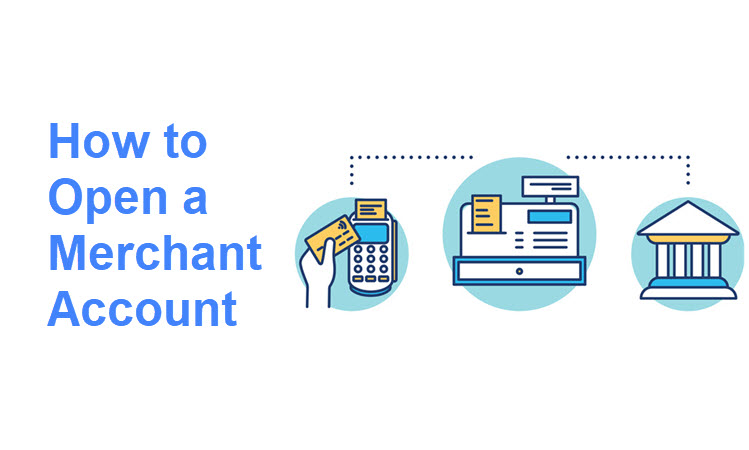Every business that wants to accept credit cards or other electronic payments needs to open a merchant account. That being said, setting up a merchant account is a complex procedure that requires upfront investments and time. Also, the merchant needs to go through an in-depth underwriting procedure.
This article explains how to open a merchant account and offer alternatives that can simplify the entire process.
What Is a Merchant Account?

A merchant account is a special kind of commercial bank account that merchants use for receiving electronic payments, typically debit or credit card payments. It is a holding account where the funds debited from customers’ accounts are kept until the settlement date, when the money is forwarded to the merchant’s designated business account or paid out via checks.
Whether you run a brick-and-mortar business with POS terminals or an online store, having a merchant account is a prerequisite for accepting electronic payments.
To open a merchant account, merchants partner with acquiring banks or merchant services providers.
Opening a Merchant Account
There are several points to consider before applying for a merchant account.
1. Choose Credit Card Brands to Process
Determine what credit card brands your customers use the most. For starters, keep in mind that Visa and Mastercard are the two most popular card associations in the world.
However, don’t neglect the potential of alternative payment methods. For instance, domestic card schemes are the most popular payment methods in some countries, like the Netherlands.
So, analyze your target audience to define the total number of card brands and payment options you need to process. Based on the collected information, ask the merchant account provider whether they allow for these additional payment options.
2. Decide on a Payment Model
When setting up a merchant account, decide on a payment model. There are two options to offer to customers:
- One-time payments. Typically used by brick-and-mortar and ecommerce stores for one-time purchases.
- Recurring payments. Typically used for selling subscription services that automatically renew monthly or annually.
Communicate your needs to the merchant account provider to check whether it provides both ways of collecting customer payments. Also, inquire if there are differences in fees and rates if you want to use both payment models.
Note: Learn about the pros and cons of monthly and annual subscriptions in our article Monthly Vs. Annual Subscriptions: What’s Better?
3. Choose a Merchant Account Provider

Before applying for a merchant account, first decide whether you will work with an acquiring bank or with a merchant services provider.
Acquiring Bank
When opening a merchant account with an acquiring bank directly, you receive your own merchant ID and a dedicated merchant account. Acquiring banks often provide additional services, such as payment gateways for online payments and support for alternative payment methods, such as ACH.
The downside is that upfront investments are required, you have more paperwork to deal with, and you pay a monthly fee even if you don’t process any payments. This approach is a viable option for established businesses that work in a low-risk industry and expect high-volume transactions each month.
Note: Dedicated high-risk merchant accounts are difficult to obtain, so if you happen to fall into the high-risk category, working with a merchant services provider makes the most sense. CCBill has decades of experience in working with merchants in high-risk industries and can help you process electronic payments safely and easily.
Merchant Services Provider
Also known as payment service providers (PSPs), merchant services providers are a one-stop shop for processing electronic payments. They usually provide an aggregated merchant account for processing payment cards, access to payment gateway technology, hosted payment forms, PCI compliance, fraud detection, payment APIs for easy integration, and third-party integrations. This option saves you time since you get everything you need to process electronic payments.
If you decide to work with a PSP, you also save money since typically there are no upfront investments and most PSPs don’t charge a flat monthly fee. Instead, the fee depends on your monthly transaction volume.
An aggregated merchant account is shared with other merchants and that’s how merchant services providers are able to save you money.
Note: Learn more about Merchant Category Codes, how to find yours and why they are important.
4. Comply Your Website with Visa and Mastercard Regulations
If you intent to process Visa and Mastercard payment cards online, your website must follow strict regulations.
Reliable merchant account providers ensure that all content and other website elements, like the checkout or the delivery policy, are compliant with Visa and Mastercard regulations for online payment processing. Moreover, they walk merchants through the rules-adjustment procedure if merchants haven’t done this beforehand.
5. Ensure PCI Compliance on Time
Payment Card Industry compliance (PCI compliance) is a set of standards brought by the PCI Security Standards Council and followed by ecommerce businesses globally to keep cardholders’ and credit card data secure and protected during online transactions.
Even though it’s not mandatory that merchants be PCI compliant before opening a merchant account, you will be given a timeframe within which to meet compliance terms and conditions.
Therefore, either carry out an independent compliance review before submitting an application form or inform the merchant account provider that you will need a compliance review.
Note: When working with a Merchant Services Provider, such as CCBill, use the provider’s hosted payment forms and the road to becoming PCI DSS compliant will be much easier since all cardholder data is processed, stored, encrypted, and transmitted by the provider.
6. Prepare Documentation

Merchant account providers request extensive documentation about a business to process an application. In order to get a merchant account as soon as possible and start accepting credit cards or other electronic payments, prepare the following documentation:
- Financial statements and credit history. Financial statements and credit history records issued by the merchant’s bank show the merchant’s cash flow and prove their financial and operational capability. They also indicate the approximate transaction volume expected by the merchant. Based on this information, the provider sets the processing fees and rates.
- Attestation of Compliance. This is a document that confirms that a merchant is PCI compliant. Merchants can obtain it on their own, before signing an agreement with a merchant account provider. Alternatively, work with a payment services provider to ensure compliance.
- Business bank account number. The merchant’s business bank account is the account to which the account provider transfers funds from the merchant account.
- Employer Identification Number (EIN). The EIN – aka the Business ID – is the unique number allocated to every business and used when filing legal and tax forms, and for social security matters.
- Business license. Every merchant must have a business license, issued by a federal state or the governmental business administration. This is a legal document that allows the merchant to run business operations. For some industries, merchants need to have more than one business license (e.g., a business registration license and an additional industry-specific license).
- Additional documentation. Merchant account providers can ask merchants to provide additional documents, from delivery and refund policies to inventory reports and business plans. Typically, the higher the processing volume that merchants require, the more documents merchant account providers request.
7. Submit an Application
Once you have talked to merchant account providers and prepared the documentation, submit an application with your chosen provider. They will walk you through the process and (should) offer support to streamline the process.
Note: Learn everything you need to know about a Merchant Statement and how to read it.
How Long Does It Take to Get a Merchant Account?
When a merchant account provider receives the merchant’s application and all the supporting documentation, they analyze the submitted data. If the merchant submits all the required documents and passes the underwriter’s analysis, their merchant account could be opened within a few hours. However, it typically takes a few days, or even weeks to examine the documentation.
Note: Bear in mind that underwriters work within regular office hours, meaning that a merchant account application submitted earlier on a business day is more likely to be reviewed and potentially approved by the end of that day.
How Much Does It Cost to Open a Merchant Account?

Merchants need to know that one portion of every successful electronic transaction goes to the fees charged by credit card associations (e.g., Mastercard and Visa) and merchant services providers.
Merchant account providers usually structure their merchant account fees in three main ways:
- Flat-rate fees. Merchant account providers charging flat-rate fees charge the same rate for all kinds of processed card transactions, regardless of the card association or issuer. These fees are expressed either via fixed percentages or a percentage plus an additional amount of money. Some merchant account providers charge different merchant account fees for transactions via credit card readers and for payments made by manually entering credit card data. Either way, the flat-rate fee within the same transaction type remains the same.
-
Tiered transaction fees. Based on the tiered pricing model, tiered transaction fees takes into account the risk that a particular merchant and their transactions bring to the merchant account provider. These payments are categorized as qualified, mid-qualified, and non-qualified. Qualified transactions are low-risk, such as when the card is physically present and the payment is made in person. Same-day settlements are also considered low risk.
On the other hand, card-not-present payments and delayed-settlement transactions pose a higher risk for merchant account providers. They are categorized as mid-qualified or non-qualified transactions, depending on the risk level.
-
Interchange-plus transaction fees. An interchange-plus transaction fee consists of the interchange fee set by the card association and the fee charged by the merchant services provider. It’s a transparent and merchant-friendly pricing model because merchants know precisely how much it will cost them to process a transaction and receive customers’ payments.
Note: High-risk merchants pay higher fees due to the high chargeback rate.
In addition, there are other common merchant account fees that providers charge:
- Application fee. Some merchant account providers might charge an application fee.
- Setup fee. The setup fee is not a universal category. Some merchant account providers charge a one-time setup fee. Others insist on quote-based pricing, meaning that the setup fee depends on the expected processing monthly volume.
- Service/Monthly fee. The merchant account service fee, also called the monthly fee, goes from $10 to $30 per merchant account per month.
- Equipment fee (for businesses using POS terminals). Merchants using POS systems or card readers provided by their merchant account provider pay an additional fee.
- Transaction fee (swiped transactions). The per-transaction fee for swiped transactions is usually 1.95%-2.0% of the transaction amount.
- Transaction fee (manually keyed transactions). The per-transaction fee for manually entered credit card transactions is usually 2.30%-2.50% of the transaction amount.
- Cross-border fee (for international payments). The cross-border fee range is 0.60%-1.25% of the total transaction amount.
How Do Merchant Accounts Work?
The role of merchant accounts in payment processing is to hold the debited funds until the settlement date. The entire process is as follows:
- A buyer wants to buy an item on the merchant’s website and provides their payment details on the checkout page.
- The payment gateway sends the buyer’s payment details to the merchant account in the acquiring bank.
- The acquiring bank forwards the payment request to the buyer’s issuing bank (the one that issued the buyer’s payment card).
- The issuing bank analyzes the request and either approves or rejects the transaction.
- If approved, the issuing bank notifies the buyer and the merchant that the transaction has been successful. If the issuing bank rejects the transaction, the payment participants will be informed about a failed transaction.
After a successful transaction, the merchant doesn’t have access to the money immediately. The money becomes available on the merchant account within the settlement period, after the issuing and acquiring bank complete the payment procedure. This usually happens anywhere between 24 hours and seven days from the payment date.
Conclusion
A merchant account is a necessity for every merchant who accepts credit cards and other forms of electronic payments.
The information presented in the guide above will help merchants open a merchant account and understand what they can expect before, during, and after the account-opening process.
